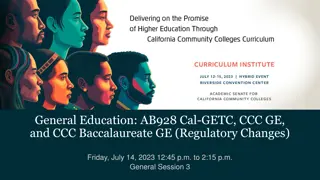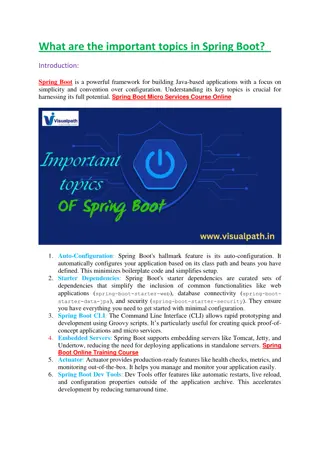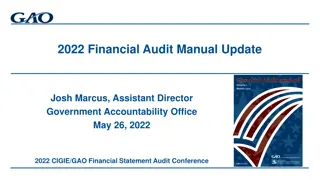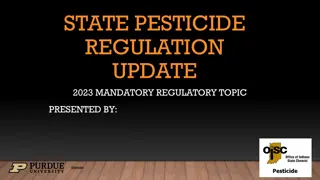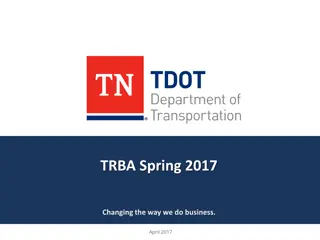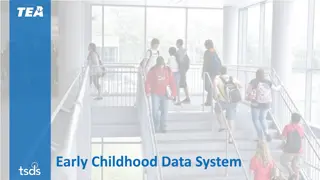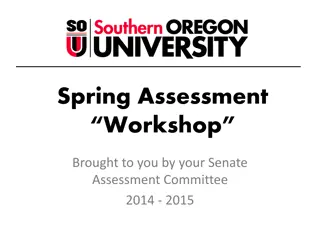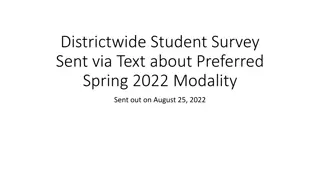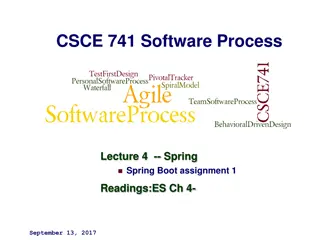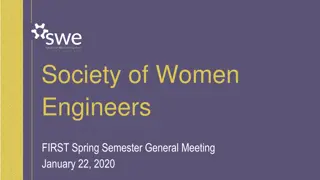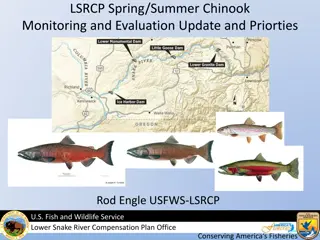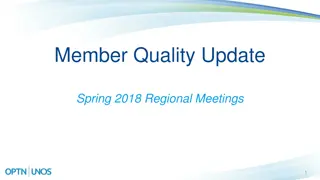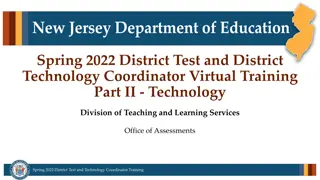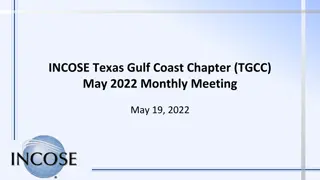General Education Program Changes and Assessment Spring Assessment Day 2022 Update
Changes in the general education program along with assessment data from Spring Assessment Day 2022 reveal significant differences between senior and freshman groups. Various analyses and the creation of assessment dashboards are highlighted in the report.
Uploaded on Oct 08, 2024 | 1 Views
Download Presentation

Please find below an Image/Link to download the presentation.
The content on the website is provided AS IS for your information and personal use only. It may not be sold, licensed, or shared on other websites without obtaining consent from the author.If you encounter any issues during the download, it is possible that the publisher has removed the file from their server.
You are allowed to download the files provided on this website for personal or commercial use, subject to the condition that they are used lawfully. All files are the property of their respective owners.
The content on the website is provided AS IS for your information and personal use only. It may not be sold, licensed, or shared on other websites without obtaining consent from the author.
E N D
Presentation Transcript
General Education Program Changes and Assessment Spring Assessment Day 2022
Agenda Program Changes Program Changes New Competency Model Transition Assessment Assessment Fall 20, Spring 21, Fall 21 Cycle IP2 Pilot Be seen. Be heard. BE INSPIRED.
Both parametric (unequal variance assumed) and non- parametric tests agreed: CCS 1 Analysis Significant difference between senior and freshman groups at p < .05
CCS 1 Analysis Nathan created an assessment dashboard: Gen Ed Assessment Dashboard
Both parametric (equal variance assumed) and non- parametric tests agreed: CCS 2 Analysis Significant difference between senior and freshman groups at p < .05
Both parametric (equal variance assumed) and non- parametric tests agreed: CCS 4 Analysis Significant difference between senior and freshman groups at p < .05
CCS 4 Analysis Our assessment dashboard: Gen Ed Assessment Dashboard
Both parametric (unequal variance assumed) and non- parametric tests agreed: CCS 5 Analysis Significant difference between senior and freshman groups at p < .05
CCS 5 Analysis Our assessment dashboard: Gen Ed Assessment Dashboard
Both parametric (unequal variance assumed) and non- parametric tests agreed: PSR 1 Analysis Insignificant difference between senior and freshman groups at p < .05
PSR 1 Analysis Our assessment dashboard: Gen Ed Assessment Dashboard
Both parametric (unequal variance assumed) and non- parametric tests agreed: PSR 2 Analysis Significant difference between senior and freshman groups at p < .05
PSR 2 Analysis Our assessment dashboard: Gen Ed Assessment Dashboard
Both parametric (equal variance assumed) and non- parametric tests agreed: IP 1 Analysis Significant difference between senior and freshman groups at p < .05
IP 1 Analysis Our assessment dashboard: Gen Ed Assessment Dashboard
Insufficient freshman sample size for comparison between senior and freshman groups. IP 2 Analysis Non-parametric test found significant difference between senior and sophomore groups at p < .05
IP 2 Analysis Our assessment dashboard: Gen Ed Assessment Dashboard
IP2 Pilot Fall 2021 Scoring Raters individually determined an overall rubric score o current rubric is created for one specific assignment Preparation 74 samples provided to raters o 73 rated by all 4 raters o 72 include student ID Close scores count as agreement o Fullest majority from all measures of central tendency Outlier Rater? o Number of unlike responses Rater W = 7, X = 7, Y = 22, Z = 16 Percent of Agreement = 81.85 (4 raters, 3 ranks)
IP2 Pilot Analysis Fall 2021 Krippendorff's Alpha 4 Raters Krippendorff's Alpha 3 Raters
Tentative conclusions Krippendorff's .667 .800 Benchmark Adjust rubric to accommodate multiple assignments Next Steps Adjust assignments to accommodate the current rubric Or Add agreed-upon scored examples as a guideline for any coder Functions like a set of instructions Share examples during Assessment Day And
IP2 Pilot Examples Response: Prompt: A four-year-old throws a temper tantrum. A 20-year-old starts a fistfight. A 75-year- old with Alzheimer s disease becomes combative. "Each person in the scenarios are ready to fight. If I were in a situation with one of these individuals, I would ask them what I can to [sic] in order to help them feel better. However, my initial reaction would be nervous. It might take me a couple seconds to think and to step into action." 1. What might these reactions have in common? 2. How would you react in a situation with one of the three individuals above?
IP2 Pilot Examples Response: 1. "These reactions all involve mental impulsivity due to brain immaturity or decline. A four-year old s brain isn t developed enough to appropriately process his/her feelings or the stimulation, especially if overwhelming, in his/her environment. A 20-year-old s brain s prefrontal cortex isn t developed for another 5 years. Therefore, executive decision-making and impulse control are difficult. A 75-year-old s brain s function is naturally declining due to the aging process. Like the others, impulses and higher-function thinking capability are harder to control and complete." Prompt: A four-year-old throws a temper tantrum. A 20-year-old starts a fistfight. A 75-year-old with Alzheimer s disease becomes combative. 1. What might these reactions have in common? 2. How would you react in a situation with one of the three individuals above? 2. "I would get on the individual s level and meet them where they re at. I would listen to their thoughts and feelings and attempt to de-escalate the situation by expressing empathy. Then I would offer a distraction or another activity suggestion in order to move on from the trigger/situation that started the response in the first place."
Transition to Critical Competency Gen Ed Implementing this model is tied to the establishment of a recertification process. Relevant faculty will reapply their courses for these competencies: PSR 1/IP 1 CC 7 (Reapply Fall 2022) PSR 2/IP 2 CC 8 (Reapply Spring 2023) CC 7 and CC 8 courses will be available Fall 2023 Remaining courses will be available Fall 2023 CCS 1 CC 1 CCS 2 CC 2 CCS 3 CC 3 CCS 4 CC 4 CCS 5 CC 5 CCS 6 CC 6 PSR 3 CC 9 Be seen. Be heard. BE INSPIRED.
Transition to Critical Competency Continued General Education Committee will continue course review Two competencies per semester Relevant faculty reapply their courses for those competencies. Over two years, each competency will have its courses recertified. Subsequently, each competency will have its courses recertified every five years. Campus Connection can handle concurrent GE programs Students follow requirement report of their catalog year Be seen. Be heard. BE INSPIRED.
New Processes Approving courses for Critical Competency Model only since Fall 2022 Now available - Updated Application Forms CC 1 CC 2 CC 3 CC 4 CC 5 CC 6 CC 7 CC 8 CC 9 Be seen. Be heard. BE INSPIRED.
Significant Learning (Fink, 2013) "Learning that makes a difference in how people live and the kind of life they are capable of living" (p. 7). Task: Course-Design Activity Purpose: Identify significant learning, learning beyond our courses. Identify applicable general education learning outcomes in courses. Align assessment with learning activities and learning intentions. Skills: Collaborate to build upon and clarify important learning in courses. Align assessment with learning activities and learning intentions. Success Criteria: I can align assessment with learning activities and learning intentions.
Dreaming Exercise (Fink, 2013) "Question: In your deepest, fondest dreams, what kind of impact would you most like to have on your students? That is, when the course is over and it is now one or two years later, what would you like to be true about students who have participated in your courses that is not true of others? What is the distinctive educational impact you would like for your teaching and your courses to have on your students?" (p. 10). Response Whiteboard
Live Your Dreams Assessment Question: What thinking, or actions, would students need to make visible to convince you and themselves that they have successfully met criteria of the educational impact you wish to make? Assessment Whiteboard Activity Question: During the course, what activities would provide students opportunities to learn your success criteria? You can include applicable general education learning outcomes.
References Fink, L. D. (2013). Creating significant learning experiences: An integrated approach to designing college courses. Jossey-Bass. Finley, A. P. (2011). How reliable are the VALUE rubrics? [PDF]. Peer Review, 13(4), 31-33. Krippendorff, K. (2004). Reliability in content analysis: Some common misconceptions and recommendations. Human Communication Research, 30(3), 411-433. https://doi.org/10.1111/j.1468-2958.2004.tb00738.x Krippendorff, K. (2011). Computing Krippendorff's alpha-reliability [PDF]. Scholarly Commons. https://repository.upenn.edu/asc_papers/43 Krippendorff, K. (2016). Misunderstanding reliability [PDF]. Methodology, (European Journal of Research Methods for the Behavioral and Social Sciences) 12(4), 139-144. https://doi.org/10.1027/1614-2241/a000119 Siefert, L. (2011). Assessing general education learning outcomes [PDF]. Peer Review, 13(4), 9-11.




